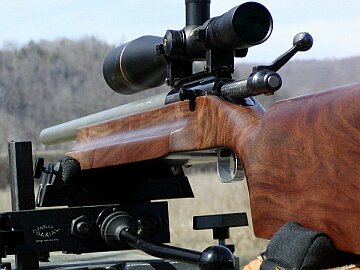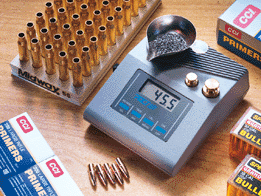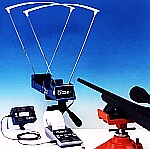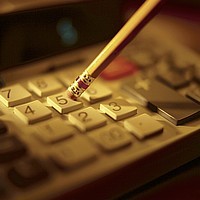 6mm vs. 6.5mm vs. Big 30s
6mm vs. 6.5mm vs. Big 30sIn 100/200 yard Benchrest shooting, the 6PPC is pretty much king of the hill. However, in the 1000-yard game, many different calibers can win. A 6BR or 6BR Improved can be very competitive at 1000 yards, despite its diminutive size and minimal recoil. A standard 6BR, after all, set the ten-shot 1000-yard world record. For a long time, the 6.5s and 30s have been dueling for top honors, with the 30s usually coming out ahead. This is evolving though, as the longer barrel life and lesser recoil of the 6.5 caliber attracts more top-level shooters.
I have shot two 30-caliber rifles and am now using a 6.5-284. Two years ago, I couldn't see myself campaigning a 6.5 at 1000 yards, but things change, and I am happy with my new 6.5-284. The 6.5-284 wins its share of matches, and is a true tack-driver when tuned right. But the majority of Aggregates are probably still being won with 30-caliber bullets shot from some kind of magnum case. The big bore shooters believe a heavier bullet flies better in unpredictable wind conditions. Ballistics experts can dispute that theory, but 30s still win the most trophies when it blows. In calm or steady-wind conditions however, a 6BR is completely capable of winning a major 1000-yd match in the hands of a skilled shooter. In fact, at the Montana 1000-yd matches, 6 Dashers regularly post small group for match, and sometimes win outright, against all other calibers, both Light Gun and Heavy. Just this past June, in Colorado, Richard Schatz set a new
6-Target NBRSA LG World Record with an 11-lb Dasher.
 Shooting Styles -- Runners vs. Pickers
Shooting Styles -- Runners vs. PickersIn all Benchrest disciplines, point-blank as well as 1000 yards, there are two basic types of shooters, each using a distinctive technique. They can go by different names in different locales, but we will refer to them as Runners v. Pickers.
Runners get a sighter shot in at the last possible moment, then if the condition holds, they'll run off 10 record rounds in well under one minute. This is feeding single shot, not from magazine! You need good equipment--a fast, smooth action and a stock that tracks like it's on rails. With the right rig, five-shot groups can be done in 15-20 seconds by the fastest. On a good day I can get 10 shots downrange in 45 seconds. If you sense a wind-change in the middle of the string, you can either wait, or do what I do and just gauge the holdoff with a quick correction of point-of-aim. It works, but you need experience and not a little bit of luck.
Pickers try to only shoot in their one preferred perfect condition, waiting between shots. Very few people do this well, without getting burned by an unseen condition shift way out at the target. There is A LOT of room for hidden drafts over 6/10ths of a mile. One old-ime picker is Earl Chronister from York, PA. He has been picking for almost 40 years at the Williamsport club. Earl often does well, but I have seen him also get burned by a condition change and end up with a two-foot group. This also happens with runners as well, so neither method is foolproof--if either one was, BR wouldn’t be so much fun!
Both methods can be equally successful. Personally I like running because there is less chance for conditions to change. Pickers have been know to take the full record time, i.e. 10-15 minutes to shoot a ten-shot group.
 Gunstocks
GunstocksA good 1000-yard stock will feature a flat fore-end, 3" or so wide. Longitudinal flats on the side work well with a box type front pad. A flat forend really tracks so much better than any other design that you can't be competitive without it. The bottom of the buttstock should have a 1/2"-3/4" flat for stability, and not much drop from grip to toe. Two of the most popular designs are the Shehane Tracker and the Tooley MBR style. McMillan, Lone Wolf and Robertson Composites all make excellent fiberglass 1000-yard BR stocks, Randy Dierks makes a great carbon fiber stock (photo above), and you can purchase excellent wood laminates from Bruce Baer, Bill Shehane, MasterClass, Richard's Customs and others. The choice of glass vs. wood is up to you. Some shooters believe wood dampens vibration better, but plenty of matches have been won with glass stocks, and the current 1000-yard world record was set with a glass Lone Wolf stock. Photo of carbon fiber Dierks stock courtesy of
Action Gun Works.

 Optics
OpticsMost top shooters use 20x to 50x scopes, both zooms and fixed-power target models. However, on the range, you'd be surprised to see how little scope power is truly needed to do well at 1000 yards. 16x is doable, with 20-25x being both popular and effective. That said, many top shooters opt for more power. Duane Capehart in Montana, who regularly shoots in the sixes and even fives, uses his Nightforce zoom at a full 42x even when the mirage is thick. I recently had
Premier Reticles boost my 8-25x Leupold LRT to 20-50x. I normally shoot at 40x or more, and I wouldn't want to go back to a lower magnification scope. I've not found the need to crank down the power, though I haven't encountered any really bad mirage since getting the boost. My philosophy is the better you can see the targets the closer you can put your shots, but I have witnessed some very good groups shot with lower-powered scopes, so don't think you need 40x or 50x power to win. Nightforce scope photos courtesy Bill Shehane,
D & B Supply.
Actions -- Factory vs. CustomCustom actions are nice to have, but they are definitely not necessary to be competitive! I had two Remingtons and now shoot a Stiller Viper, but not because I felt I needed the custom. There have been some very fine groups shot with blue-printed Remington actions. Most Rem actions will need to be trued by a competent gunsmith to keep things concentric. Keep in mind that by the time you've paid the smith for the action-truing, you will have $600 or more invested in the Rem action. For $900 you can get a Stiller Viper action and that price includes bottom metal and scope rings. A good custom action will cycle more smoothly, and tolerances will be sufficiently uniform that you can normally just screw on a barrel and drop the action into the stock. While most 100/200 BR shooters glue their actions into their stocks, nearly all 1000-yard guns have bolt-in actions, using pillars and glass bedding. The Heavy Guns often employ barrel blocks. As for other components, two-ounce match triggers like the Jewell are very nice to have, but you can easily get away with a tuned 700 trigger if that is what you have.
Making Superb Ammunition -- The Key to Accuracy
To be successful in this game you need near-perfect ammo. You must achieve consistency in every single variable: bullets, brass, powder, primers, seating depth, neck tension. You want your rounds to be as uniform as possible in every respect.
There's a wide choice of fine bullets. Off-the-shelf Sierras, Bergers and Hornadys, as well as pricey custom bullets, can all shoot well. But any brand of bullet, whether factory-made or custom, will benefit from batching and sorting by bearing surface length and by weight. While custom bullets tend to be more concentric and uniform in weight, they can still benefit from judicial sorting.
You need to pay as much attention to your brass as you do to your bullets. I neck-turn my cases to get the most uniform neck wall thickness. Outside neck-turning is usually beneficial, but is not required if you start with very good brass like Lapua. To make the most concentric ammo you need a premium bullet-seater. I find a Wilson-type inline seater consistently yields the lowest bullet/case runout, and therefore the straightest rounds. With a die that's threaded into a press, things have more chance of getting out of line.
All case preparation needs to be done with the goal of making every part of the bullet-delivery system concentric relative to everything else: receiver, barrel, bolt, barrel, casing, bullet, bore. The idea is to get everything to line up on the same axis down the center of the bore. The closer you get to this, the smaller your groups will be.
In 100/200 yard Benchrest you will find most competitors load their ammo throughout the day. In 1000-yard BR you rarely see this. Believe it or not your gun will tell you whether it likes ammo loaded right before it is shot, or several days in advance. I load at least 48 hours before a match. One time I tried loading at the range right before a shoot-off. No dice. I went from an 8" group to an ugly group with 12" of vertical. Just by not loading ahead of time, I went from more than respectable to out of the running. I'm really not sure what the problem was, but now I always get my ammo ready well in advance.
Wind Drift, Vertical Velocity Dispersion, and AccuracyShooting at 1000 yards is a LOT different than drilling bugholes with a 6PPC at 100 yards. Horizontal wind deflection increases with the square of the distance, so a 5 mph crosswind shift can put you completely off paper at 1000 yards. Those who win, place or show in 1000-yard Benchrest know how to gauge the wind and deal with rapidly-changing conditions and mirage. But even the best wind wizard won't prevail without an exceptionally accurate gun--one able to put five shots into .25" or less at 100 yards. To shoot small groups at 1K, your reloads must be near-perfect as well. Even very small variations in velocity give you big vertical spreads at 1000 yards. There's absolutely no way you can shrink the verticals if your ammo isn't up to snuff. When crafting 1K ammo, you must keep Extreme velocity Spread (ES) low. If your load shows less than 20fps ES when run through a chronograph, then it's competitive. However, the top shooters are probably using ammo with an ES of 10fps or less. If you think you have a good load, simply switching primers may reduce your ES dramatically. Neck tension also plays a huge role in ES. Like golf though, the smallest number you can get is the best. With high Extreme Spread, it is simply impossible to shoot single-digit groups at 1000, because bullet speed variances will produce large vertical dispersion, even if your aim is perfect and there is no cross-wind.
Practice--Even at 300 Yards--Makes Perfect How does one practice for 1k shooting? Most folks don't have a 1000-yard range within close proximity. I find that 300 yards is enough distance to get a meaningful sense of your rig's accuracy. It's also long enough to test your wind-doping skills. As noted in Part I, when practicing at 300 yards, your goal should be to shoot groups NO bigger than 1". This is the bottom line to be competitive at 1000 yards. If you can't get to a 300-yard range, you can still benefit from load testing and practice at 200 yards.

As noted before, your ammo needs to have a narrow extreme spread to shoot competitively at 1000 yards. This is easier when you have a chronograph. The triple-sensor
Oehler Chrono is the best, but a $120 Chrony Beta Master (photo left) will do the job. If you don't own a chrono, you will need to practice well beyond 300yds to see if you are getting vertical dispersion. The larger your extreme velocity spread (ES), the more vertical you will see. A 10fps ES will produce 1/2" or less vertical at 300 yards. It doesn't matter if you are the best shooter in the world--you can't shoot a small group at 1k without minimal velocity spread!
 The Price of Entry -- What it Costs to Play at 1K
The Price of Entry -- What it Costs to Play at 1KWith a
Shehane Tracker stock ($295), a trued Rem 700 action ($600), Shilen Match Select Barrel from
The Barrelman ($240), and a Weaver or Sightron 36x scope ($380), you can be in business for about $1700, including smithing ($200-$400) by a competent rifle-builder. Add another $250 if you want fancy rings, premium trigger guard and a Jewell trigger. There are cheaper ways to go, but you don't want to skimp on the barrel or the stock. We'd pay the extra $50 or so for a Hart, Krieger or Broughton barrel. If you have a donor Rem action, you only need to have it trued, saving you $400 or so.
OK, now you've got the gun. You still need front pedestal rest, a rear bag, and dies. A set of
Redding Comp dies runs $100 or so, and the better front rests start at about $250, running all the way up to $750 for a
Farley Co-Axial. So now you're at $2100 for a competitive rig, and you haven't loaded a single round yet. With the costs of bullets, powder, and brass, you will probably have $2500 tied up when you're finally set to shoot your first match. Hey, who ever said accuracy was cheap?
Copyright © 2004, 6mmBR.com, All Rights Reserved. No reproduction without advance approval in writing from 6mmBR.com.